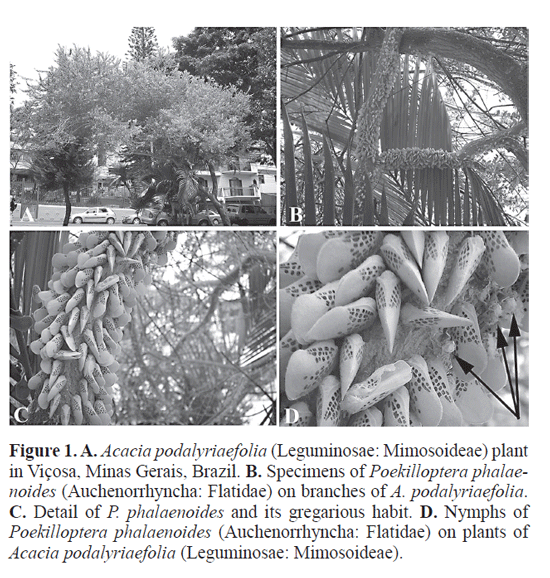Services on Demand
Journal
Article
Indicators
-
 Cited by SciELO
Cited by SciELO -
 Access statistics
Access statistics
Related links
-
 Cited by Google
Cited by Google -
 Similars in
SciELO
Similars in
SciELO -
 Similars in Google
Similars in Google
Share
Revista Colombiana de Entomología
Print version ISSN 0120-0488On-line version ISSN 2665-4385
Rev. Colomb. Entomol. vol.37 no.1 Bogotá June 2011
Scientific note
Occurrence of Poekilloptera phalaenoides (Hemiptera: Flatidae) on Acacia podalyriaefolia (Mimosoideae) in Viçosa, Minas Gerais, Brazil
Presencia de Poekilloptera phalaenoides (Hemiptera: Flatidae) en Acacia podalyriaefolia (Mimosoideae) en Viçosa, Minas Gerais, Brasil
EVALDO MARTINS PIRES1, ISABEL MOREIRA DA SILVA2, ADRIANO ELIAS PEREIRA3 and JOSÉ COLA ZANUNCIO4
1 D.Sc. Instituto de Ciências Naturais, Humanas e Sociais, Unversidade Federal de Mato Grosso, 78557-000 Sinop, MT, Brazil. evaldo@ufmt.br Correspondence author.
2 M.Sc. Student. Departamento de Fitotecnia, Universidade Federal de Viçosa, 36570-000 Viçosa, MG, Brazil.
3M.Sc. Animal and Plant Health Inspection Service (APHIS). Rua Thomas Deloney, 381. 04710-110, São Paulo, Brazil.
4 Ph.D. Departamento de Biologia Animal, Universidade Federal de Viçosa, 36570-000 Viçosa, MG, Brazil.
Recibido: 5-jul-2010 - Aceptado: 24-ene-2011
Resumen: Los adultos y las ninfas de Poekilloptera phalaenoides (Auchenorrhyncha: Flatidae) se encontraron en plantas de Acacia podalyriifolia (Leguminosae: Mimosoideae) en Viçosa, Minas Gerais, Brasil, en octubre de 2007. Este es el primer registro para la municipalidad de Viçosa y en plantas de A. podalyriaefolia, sobre el cual puede completar su ciclo de vida entero.
Palabras clave: Manguifera. Anona. Eucalyptus. Citrus. Theobroma.
Abstract:Adults and nymphs of Poekilloptera phalaenoides (Auchenorrhyncha: Flatidae) were found on Acacia podalyriaefolia (Leguminosae: Mimosoideae) in Viçosa, Minas Gerais, in October 2007. This is the first record of this insect in the municipality of Viçosa and on plants of A. podalyriaefolia on which it can complete its full life cycle.
Key words: Manguifera. Anona. Eucalyptus. Citrus. Theobroma.
Introduction
Poekilloptera phalaenoides (L., 1758) (Auchenorrhyncha: Flatidae) is recorded from Mexico through and Brazil (Maes 2004). In Brazil it has been reported in Bahia, Goiás, Mato Grosso, Minas Gerais, Pará, Paraíba, Rio de Janeiro, Rio Grande do Sul, Roraima, São Paulo and Sergipe states (Araújo et al. 1968; Querino et al. 2007; Silva 2009; Ferreira et al. 2009). Poekilloptera phalaenoides is characterized by having general pale yellowish color with black spots on the tegmina and wings (Figs 1C-D ) (Costa Lima 1942). It is phytophagous (Maes 2004) and excretes a sticky substance that causes sooty mold to grow on the plant and cover leaves and branches, obstructing to some level the plant breathing, transpiration and photosynthesis (Querino et al. 2007). Plants considered as potential hosts for P. phalaenoides include species of the genera Cassia, Delonix (Caesalpiniaceae), Cajanus, Dipteryx (Fabaceae), Manguifera (Anacardiaceae), Anona (Anonaceae), Eucalyptus, Psidium (Myrtaceae), Rosa, Prunus (Rosaceae), Coffea (Rubiaceae), Citrus (Rutaceae), Theobroma (Sterculiaceae), Enterolobium, Pithecelobium, Inga, Albizia and Acacia (A. mangium) (Mimosaceae) (Maes 2004; Querino et al. 2007).
Adults and immature stages of P. phalaenoides were found on plants of A. podalyriaefolia (Leguminosae: Mimosoideae) on October 2007, in Viçosa county, state of Minas Gerais (coordinates: 20º45'28.2”S; 42º52'26.6”W at 656 masl altitude). This is an exotic plant in the Brazilian fauna, native to Australia (Fig 1A). Specimens of P. phalaenoides were collected and sent to Dr. Stephen W. Wilson from Department of Agriculture of the University of Central Missouri, USA, for identification. The plant was identified by Dr. Antônio Lelis Pinheiro from the Department Plant Biology of the Federal University of Viçosa (UFV). These insects were observed feeding exclusively on branches of this plant, and the observed symptom was the presence of long, curled filaments of waxy exudate covering the branches. After this observation, it was concluded that A. podalyriaefolia can be a potential host for P. phalaenoides (Figs. 1A-B) because in addition to the adults, there were nymphs on the branches of the plant (Fig 1D, arrows), indicating that the plant can be not only a refuge or shelter but also a place to reproduction.
Cited literature
ARAÚJO E SILVA, A.G.; GONÇALVES, C.R.; GALVÃO, D.M.; GONÇALVES, A.J.L; GOMES, J.; SILVA, M.N.; SIMONI, L. 1968. Quarto catálogo que vivem nas plantas do Brasil; seus parasitos e predadores. Parte II, 1º tomo. Rio de Janeiro, M.A. Laboratório Central de Patologia Vegetal. 622 p. [ Links ]
COSTA LIMA, A.M. 1942. Insetos do Brasil. 3º tomo (Homopteros). Rio de Janeiro, Escola Nacional de Agronomia. 327 p. [ Links ]
FERREIRA, G.A.; VELOSO, V.R.S.; VELOSO NAVES, R.; NASCIMENTO, J.L.; CHAVES, L.J. 2009. Biodiversidade de insetos em Pequizeiro (Caryocar brasiliense, Camb.) no cerrado do Estado de Goiás, Brasil. Agrociencia, 13 (2): 14-31. [ Links ]
QUERINO, R.B.; TONINI, H.; MARSÁRO JÚNIOR, A.L & COUCEIRO, S.R.M. 2007. O manejo de Acacia mangium Willd (Fabaceae) tem efeito na infestação da cigarrinha Poekilloptera phalaenoides L. (Hemiptera: Flatidae)? Boletim de Pesquisa e Desenvolvimento 04. Embrapa. 15 p. [ Links ]
MAES, J.M. 2004. Insectos asociados a algunos cultivos tropicales en el Atlántico de Nicaragua. Revista Nicaraguense de Entomologia, 64: (1): 1-134 p. [ Links ]
SILVA, M.M. 2009. Diversidade de insetos em diferentes ambientes florestais no município de Cotriguaçu, estado de Mato Grosso. Master's Dissertation, UFMT, 125 p. [ Links ]















